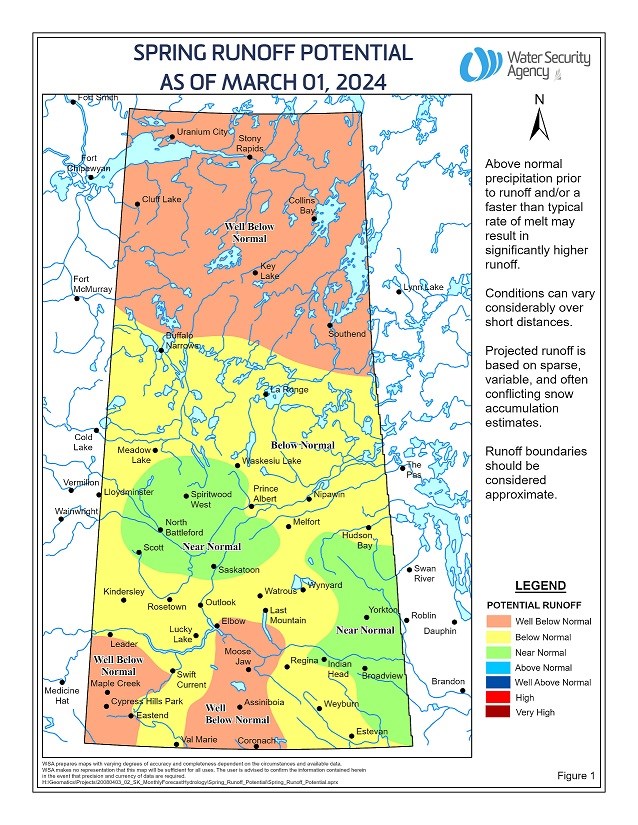REGINA — The Water Security Agency (WSA) has issued the Spring Runoff Forecast for 2024.
Near-normal runoff is expected in the Saskatoon area and west toward Biggar, as well as in the eastern portions of the grain belt along the Manitoba border. The remainder of the province is expected to experience below to well below normal runoff this spring.
As of March 4, snowpack generally ranges from below to well-below normal across the province. Recent snowstorms in early March brought up to 40 centimetres of snow to much of southern and central Saskatchewan, which has improved runoff potential for the province.
"Although the recent snowfall will help our situation and our producers this spring, we as a government, will still be prepared to help those areas with dry conditions," said David Marit, the minister responsible for the Water Security Agency.
"More moisture will be needed as temperatures continue to stay above zero. WSA will still be taking as many proactive measures as possible to prepare for changing conditions."
This runoff forecast report updates the preliminary report issued in February 2024, with the inclusion of data from snowpack surveys.
Grant Devine Lake was at 561.1 metres, as of March 1, and has a forecasted peak spring level of 561.8 metres. Its full supply level is 562 metres and its normal summer operating level is 561.5 metres.
Boundary Dam was at 559.9 metres, as of March 1, and its projected peak spring level is 560.8 metres. Full supply level is 560.83 metres and the normal summer level is 506.5 metres.
Rafferty Dam's depth was at 549.5 metres, and the expected peak spring level is 549.6 metres. Full supply level is 550.5 metres and the normal summer operating level is 550 metres.
In the Souris River basin, freeze-up conditions were near normal in 2023. The runoff potential is currently projected to range from near normal in the Moose Mountain Creek basin to below normal in the Long Creek basin.
"The March snow brought five to 30 centimetres of snow to the basin, which improved conditions; however, runoff is still projected to be below normal. With the drier conditions, no additional releases will be required," the WSA wrote.
As of March 1, only Boundary Reservoir has the potential of filling this spring, the WSA said. Any excess water from Boundary would be diverted to Rafferty. Currently, both Rafferty Reservoir and Grant Devine Lake are expected to be in the normal operating range following the snowmelt runoff.
Detailed forecasts for the Souris River Basin are developed on or near the first and 15th of each month, beginning in February, up until the snowmelt runoff event.
Over the winter, the WSA took action with conservative operating plans focused on retaining water supplies that has helped keep water levels at most major reservoirs at or above normal levels for this time of year.
The spring runoff is dependent on fall soil moisture, snowpack water content, and how quickly the snowpack melts.
The WSA continues to work internally and across other government agencies to identify opportunities and programming to support communities and producers who may be facing challenges from dry conditions.
It continues to monitor moisture conditions and forecasted weather patterns in preparation for the spring runoff and will issue updates to the runoff report throughout the runoff period.




